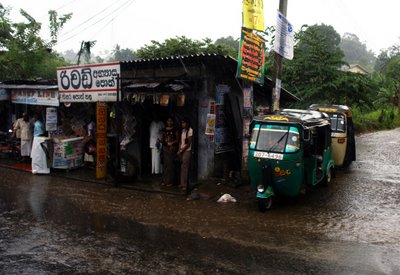Just 35 km south of India in the Indian Ocean is a small island known as Sri Lanka. One of the most bio-diverse islands in the world, it boasts rich tropical vegetation in the mountains and soft sandy beaches which circle its shores. The island gets a generous amount of monsoon rain and within two hours you can experience a rapid change in climate.

Rice paddies line the roads that lead down to the coast from the the mountains. A uniforminty amongst this lush landscape, a greenery that dazzles the eyes and soothes the mind.

The rain is heavy, but comes and goes quickly. Umbrellas quickly double up as parasols to provide shade from the mid day heat, as well as protection from the rain, not that it matters... weary feet find the cool sensation of fresh puddles.

There are people everywhere on the streets, walking from one place to another. In the mountians, the rain smells fresh and romances the senses. It jogs the memory and reminds one of how utterly wonderfully nature is.

The country is for the most part poor and according to the World Bank 23% of people still live under the national poverty line: "Between 1990/91 and 2002 per capita consumption increased by 29% in real terms. The average consumption for the richest 20% of the population increased by 50%, while that for the poorest 20% barely increased by 2%. Inequality between urban and rural areas has been also widening with residents in rural/remote areas being left out of benefits from economic development."
Time stands still in Sri Lanka, a barber shop in the capital Colombo harks back to the 1950s. This barber shop is located one block from the presidential residence and the central bank, which was blown up in 1996, causing an eleven storey building to collapse and killing at least 50. Photos are forbidden on the street outside, but the barbers didn't seem to mind.

Central Colombo away from the bright lights of prosperous development.

Colombo airport is locked in the 1970s.

The sign is written in Sinhalese, English and Tamil.

But among the beauty and memories of decades gone by, there is a terrible tragedy, the displacement of thousands of people. Firstly by the tsunami that struck on December 26, 2004, killing over 30,000 people. And now by the war that is raging in the north east of the country - some of the worst hit areas by the tsunami.
Two years ago, a new government was elected and critics say that the recent upsurge in violence from the Tamils, which started over a water supply to Muslim farmers two weeks ago, is due to the way in which the government has been dealing with the Tamil Tiger rebels (LTTE) - or not dealing with them. As is always the case with any type of resistance, when negotiations and dialogue disappears from the spectrum the more radicalised the resistanc becomes and not without reason. Although, Tamils do experience rights, what they want is their own homeland - an autonomous area in the north east of the country, much of which is currently under LTTE rule.
Two weeks ago, the military launched an offensive on the LTTE in order to get back the water supply to civilians on humanitarian grounds. This fighting spilled over to Muttur, a city with a population of about 68,000 civilians. Sri Lanka is home to mix of Sinhalese (approx 72%) and Tamil (approx 18%), of different religions; Buddists, Hindus, Buddhists, Muslims and Christians, all of whom lived in the city.
The residents of Muttur fled south after hiding in schools for 24 hours to escape the shelling and artillery fire. Co-ordinated, by ordinary people, an exodus of civilians to get out of the city to safety headed south. It took them a journey of three days on foot to reach Kantale, a village with a population of 2000 people, where they finally found refuge. Needless to say refugee camps have gone from 4 to 26 in four days. There are some 30,000 people now in refugee camps in kantale, so where are the rest of the civil population? Lying dead on the road inside the conflict zone? Or still hiding without water?
Eye-witness reports say that on the way out of Muttur as people were passing the checkpoints, young Muslim men were being targetted by the LTTE. Singled out they were shot at point blank range (seen as government informers), while some of them were recruited by the LTTE.
It's difficult to say who started what, and who is to blame. Yes, the government has done well at not dealing with the issue, and the water supply fude seems to have been a pretext to a planned war from the LTTE to recover their so-called homeland. Either way, many people are suffering - a human population who have already been through so much because of the tsunami are now suffering the agreesion of war. Whether the peace will come back remains to be see, but with the world not seemingly bothered by the conflict, it does look like it will conitnue for some time.


2 comments:
Good to hear from you.
Keep up the great reporting,
dad........
Rick Sabral,
Sharon, Kansas
Thanks pops!
Post a Comment